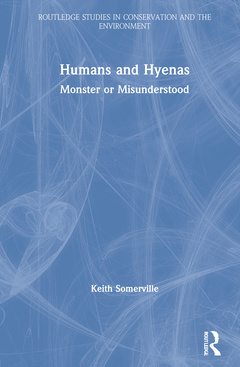Humans and Hyenas Monster or Misunderstood Routledge Studies in Conservation and the Environment Series

Humans and Hyenas examines the origins and development of the relationship between the two to present an accurate and realistic picture of the hyena and its interactions with people. The hyena is one of the most maligned, misrepresented and defamed mammals. It is still, despite decades of research-led knowledge, seen as a skulking, cowardly scavenger rather than a successful hunter with complex family and communal systems.
Hyenas are portrayed as sex-shifting deviants, grave robbers and attackers of children in everything from African folk tales through Greek and Roman accounts of animal life, to Disney?s The Lion King depicting hyenas with a lack of respect and disgust, despite the reality of their behaviour and social structures. Combining the personal, in-depth mining of scientific papers about the three main species and historical accounts, Keith Somerville delves into our relationship with hyenas from the earliest records from millennia ago, through the accounts by colonisers, to contemporary coexistence, where hyenas and humans are forced into ever closer proximity due to shrinking habitats and loss of prey. Are hyenas fated to retain their bad image or can their amazing ability to adapt to humans more successfully than lions and other predators lead to a shift in perspective?
This book will be of great interest to students and scholars in the environmental sciences, conservation biology, and wildlife and conservation issues.
Introduction; 1 Dramatis Personae: The spotted, striped and brown hyenas; 2 Humans and hyenas from the Pleistocene to the Holocene; 3 Humans and hyenas in Africa to 1600CE; 4 Humans and hyenas in West, Central and South Asia to 1600CE; 5 Humans and hyenas from 1600CE to the end of the 19th century; 6 Persecution increases under colonial rule; 7 Contemporary Africa, West, Central and South Asia; 8 Myths and representations from early humans to The Lion King
Keith Somerville is a Member of the Durrell Institute of Conservation and Ecology at the University of Kent, UK, where he is a professor at the Centre for Journalism. He is a Senior Research Fellow at the Institute of Commonwealth Studies, a Fellow of the Zoological Society of London, UK, and a Member of the IUCN CEESP/SSC Sustainable Use and Livelihoods Specialist Group.
Date de parution : 03-2021
15.6x23.4 cm
Date de parution : 03-2021
15.6x23.4 cm
Thèmes de Humans and Hyenas :
Mots-clés :
Crocuta Crocuta; conservation; Striped Hyenas; African conservation; Brown Hyenas; wildlife conservation; Spotted Hyenas; conservation biology; Wild Ungulates; human-wildlife conflict; Wild Dogs; environmental history; Cave Hyena; African animals; Crocuta Crocuta Spelaea; defamed mammals; Den Sites; African folk tales; Western Sahara; hyena-human relationship; Central African Republic; wildlife habitat; Late Early Pleistocene; conservation issues; Millennium BCE; Retaliatory Killing; Southern Kalahari; Bone Assemblages; Crocuta Spelaea; Camera Traps; Ngorongoro Conservation Area; Livestock Predation; Threaten IUCN Category; Large Carnivores; Middle Pleistocene; South Sudan; Early Pleistocene



